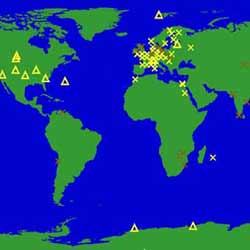
Global map of brightness increases. Yellow represents an increase, brown is decreasing. Image credit: PNL. Click to enlarge.
Earth’s surface has been getting brighter for more than a decade, a reversal from a dimming trend that may accelerate warming at the surface and unmask the full effect of greenhouse warming, according to an exhaustive new study of the solar energy that reaches land.
Ever since a report in the late 1980s uncovered a 4 to 6 percent decline of sunlight reaching the planet’s surface over 30 years since 1960, atmospheric scientists have been trying out theories about why this would be and how it would relate to the greenhouse effect, the warming caused by the buildup of carbon dioxide and other gasses that trap heat in the atmosphere.
Meanwhile, a group led by Martin Wild at the Swiss Federal Institute of Technology in Zurich, home of the international Baseline Surface Radiation Network (BSRN) archive, had gone to work collecting surface measurements and crunching numbers.
“BSRN didn’t get started until the early ’90s and worked hard to update the earlier archive,” said Charles N. Long, senior scientist at the Department of Energy’s Pacific Northwest National Laboratory and co-author of a BSRN report in this week’s issue (Friday, May 6) of the journal Science.
“When we looked at the more recent data, lo and behold, the trend went the other way,” said Long, who conducted the work under the auspices of DOE’s Atmospheric Radiation Measurement (ARM) program.
Data analysis capabilities developed by ARM research were crucial in the study, which reveals the planet’s surface has brightened by about 4 percent the past decade. The brightening trend is corroborated by other data, including satellite analyses that are the subject of another paper in this week’s Science.
Sunlight that isn’t absorbed or reflected by clouds as it plunges earthward will heat the surface. Because the atmosphere includes greenhouse gasses, solar warming and greenhouse warming are related.
“The atmosphere is heated from the bottom up, and more solar energy at the surface means we might finally see the increases in temperature that we expected to see with global greenhouse warming,” Long said.
In fact, he said, many believe that we have already been seeing those effects in our most temperature-sensitive climates, with the melting of polar ice and high altitude glaciers.
The report’s authors stopped short of attributing a cause to the cycle of surface dimming and brightening, but listed such suspects as changes in the number and composition of aerosols?liquid and solid particles suspended in air?and how aerosols affect the character of clouds. Over the past decade, the ARM program has built a network of instrumentation sites to sample cloud characteristics and energy transfer in a variety of climates, from tropical to polar.
“The continuous, sophisticated data from these sites will be crucial for determining the causes,” Long said.
Long also pointed out that 70 percent of the planet’s surface is ocean, for which we have no long-term surface brightening or dimming measurements.
PNNL (www.pnl.gov) is a DOE Office of Science laboratory that solves complex problems in energy, national security, the environment and life sciences by advancing the understanding of physics, chemistry, biology and computation. PNNL employs more than 4,000 staff, has a $650 million annual budget, and has been managed by Ohio-based Battelle since the lab’s inception in 1965.
Original Source: PNL News Release
